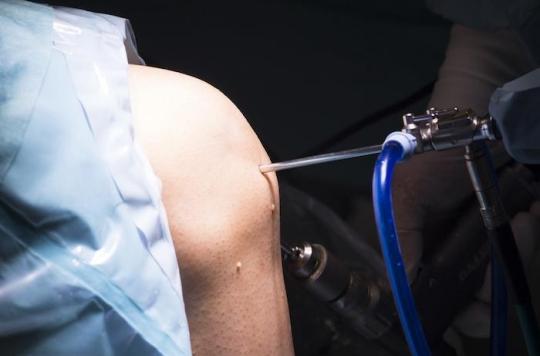In the event of a degenerative meniscus tear, arthroscopic meniscal surgery does not provide any benefit compared to rehabilitation. It should therefore not be the first choice of treatment.

In people aged 45 to 70 years, suffering from a degenerative meniscal tear without evidence of knee blockage, instability or severe osteoarthritis, a new well-conducted trial does not show a difference at 2 years between knee rehabilitation (16 sessions over 6 weeks) and surgery (“arthroscopic partial meniscectomy”).
After a 24-month follow-up, the Knee Functional Capacity Assessment (IKDC) scores improved by 26.2 points in the surgery group and by 20.4 points in the rehabilitation group. The difference is not sufficient to be clinically significant (at least 8 points statistically) and is therefore compatible with an equivalence of the 2 strategies (“non-inferiority”).
Appeared in the JAMA, this trial, which comes after others, justifies an initial conservative approach through rehabilitation in the event of degenerative meniscal tear.
Too frequent intervention
Knee arthroscopy is one of the most widely performed surgical procedures in the world. However, MRI studies show that 60% of people over 50 without knee pain have MRI signs suggestive of meniscal degeneration, most often in the presence of osteoarthritis. In this type of patient, when they have knee pain, the challenge will therefore be to determine the real cause of the pain (meniscus, osteoarthritis or other cause).
Low benefit in case of simple degeneration
People with mild or mild osteoarthritis and meniscus alteration were previously considered candidates for arthroscopic surgery. From studies earlier comparing arthroscopy and rehabilitation have, however, given mixed results.
Knee arthroscopy with partial meniscal resection is ineffective in people with established osteoarthritis with undisplaced meniscal degeneration. Recently, 6 clinical trials in patients with simple meniscal degeneration with mild or moderate osteoarthritis, all showed no benefit of arthroscopy compared to non-surgical treatment or sham surgery up to 2 years of follow-up post -intervention.
A systematic analysis of all these studies concluded that there is a statistically significant benefit, but clinically not visible. The advantages of arthroscopy are therefore now clearly in question in this population.
An intervention that is not without risk
While the effectiveness of meniscal arthroscopic surgery is questioned, it is not uninteresting to know that this intervention is not without risk either. In the Lancet, a team of researchers compiled all the complications that arose after knee arthroscopy in hospitals in Great Britain, between 1997 and 2017.
Overall, the risk is low (0.3%), but there are some serious complications: pulmonary embolism (0.08%), infections requiring reoperation (0.13%), especially in cases of advanced age or associated disease. The risk of mortality decreased rapidly between 1997 and 2017, but not the risk of embolism or infection.
A reduction in indications in perspective
It is important to note that most of the negative studies have concerned degenerative meniscal tears. Traumatic, displaced or blocking meniscal tears (bucket handle tear), in particular in young athletes, pose a totally different therapeutic problem and arthroscopy with partial meniscal resection is objectively effective this time, even in the presence of a mild osteoarthritis.
In degenerative meniscal tears from the age of 50, without displacement or blockages, orthopedic surgeons and sports physicians must now adopt this non-interventional approach through rehabilitation, at least initially, and integrate it into their treatment strategy. The scientific evidence strongly supports this approach and the recommendations need to change.

.

















